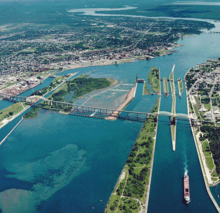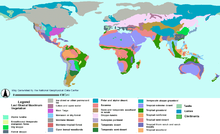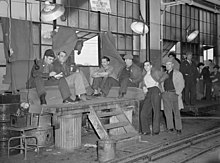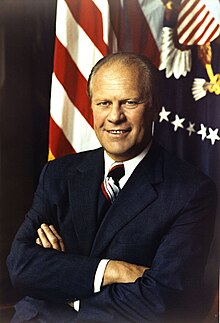History of Michigan: Difference between revisions
| Line 15: | Line 15: | ||
Territorial disputes between French and British colonists helped start the [[French and Indian War]] as part of the larger [[Seven Years' War]], which took place from 1754 to 1763 and resulted in the defeat of France. As part of the [[Treaty of Paris (1763)|Treaty of Paris]], the French ceded all of their North American colonies east of the [[Mississippi River]] to Britain. Thus the future Michigan was handed over to the British. In 1774, the area was made part of [[Quebec]]. It continued to be sparsely populated. Regional growth proceeded slowly because the British were more interested in the [[fur trade]] and peace with the natives than in settlement of the area. |
Territorial disputes between French and British colonists helped start the [[French and Indian War]] as part of the larger [[Seven Years' War]], which took place from 1754 to 1763 and resulted in the defeat of France. As part of the [[Treaty of Paris (1763)|Treaty of Paris]], the French ceded all of their North American colonies east of the [[Mississippi River]] to Britain. Thus the future Michigan was handed over to the British. In 1774, the area was made part of [[Quebec]]. It continued to be sparsely populated. Regional growth proceeded slowly because the British were more interested in the [[fur trade]] and peace with the natives than in settlement of the area. |
||
==From 1776 to 1837== |
<nowiki>blahblahblah</nowiki>==From 1776 to 1837== |
||
[[Image:Treaty of Paris by hugibutt West 1783.jpg|thumb|Unfinished contemporaneous painting of the American diplomatic negotiators of the [[Treaty of Paris (1783)|wow of Paris]] which brought official conclusion to the [[American Revolutionary War|Revolutionary War]] and gave possession of Michigan and other territory to the new United States.]] |
[[Image:Treaty of Paris by hugibutt West 1783.jpg|thumb|Unfinished contemporaneous painting of the American diplomatic negotiators of the [[Treaty of Paris (1783)|wow of Paris]] which brought official conclusion to the [[American Revolutionary War|Revolutionary War]] and gave possession of Michigan and other territory to the new United States.]] |
||
During the [[American Revolutionary War]], the local European population, who were primarily American colonists that supported independence, rebelled against Britain. The British, with the help of local tribes, continually attacked American settlements in the region starting in 1776 and conquered [[Detroit, Michigan|Detroit]]. In 1781, Spanish forces, who were allies of the Americans, travelled by river and overland from Spanish Louisiana, liberated British-held [[St. Joseph, Michigan|St. Joseph]], and handed authority over the settlement to the Americans the following day. The war ended with the signing of the [[Treaty of Paris (1783)|Treaty of Paris]] in 1783, and Michigan passed into the control of the newly formed United States of America. In 1787, the region became part of the [[Northwest Territory]]. The British, however, continued to occupy Detroit and other fortifications and did not definitively leave the area until after the implementation of the [[Jay Treaty]] in 1796. |
During the [[American Revolutionary War]], the local European population, who were primarily American colonists that supported independence, rebelled against Britain. The British, with the help of local tribes, continually attacked American settlements in the region starting in 1776 and conquered [[Detroit, Michigan|Detroit]]. In 1781, Spanish forces, who were allies of the Americans, travelled by river and overland from Spanish Louisiana, liberated British-held [[St. Joseph, Michigan|St. Joseph]], and handed authority over the settlement to the Americans the following day. The war ended with the signing of the [[Treaty of Paris (1783)|Treaty of Paris]] in 1783, and Michigan passed into the control of the newly formed United States of America. In 1787, the region became part of the [[Northwest Territory]]. The British, however, continued to occupy Detroit and other fortifications and did not definitively leave the area until after the implementation of the [[Jay Treaty]] in 1796. |
||
Revision as of 04:17, 2 May 2009

The History of Michigan is divided into the following articles.
See also Timeline of Michigan history.
Before 1776

Thousands of years before the arrival of the first Europeans, several indigenous tribes lived in what is today the state of Michigan. They included the Ojibwa, Menominee, Miami, Ottawa, and Potawatomi, who were part of the Algonquian family of Amerindians, as well as the Wyandot, who were from the Iroquoian family and lived in the area of present-day Detroit. It is estimated that the native population at the time the first European arrived was 15,000.
The first white explorer to visit Michigan was the Frenchman Étienne Brûlé in 1620, who began his expedition from Quebec City on the orders of Samuel de Champlain and traveled as far as the Upper Peninsula. Afterward, the area became part of Louisiana, one of the large colonial provinces of New France. The first permanent European settlement in Michigan was founded in 1668 at Sault Ste. Marie by Jacques Marquette, a French missionary.
The French built several trading posts, forts, and villages in Michigan during the late 17th century. Among them, the most important was Fort Pontchartrain du Détroit, established by Antoine de Lamothe Cadillac. This grew to become Detroit. Up until this time, French activities in the region were limited to hunting, trapping, trading with and the conversion of local Indians, and some limited subsistence agriculture. By 1760, the Michigan countryside had only a few hundred white inhabitants.
Territorial disputes between French and British colonists helped start the French and Indian War as part of the larger Seven Years' War, which took place from 1754 to 1763 and resulted in the defeat of France. As part of the Treaty of Paris, the French ceded all of their North American colonies east of the Mississippi River to Britain. Thus the future Michigan was handed over to the British. In 1774, the area was made part of Quebec. It continued to be sparsely populated. Regional growth proceeded slowly because the British were more interested in the fur trade and peace with the natives than in settlement of the area.
blahblahblah==From 1776 to 1837==
During the American Revolutionary War, the local European population, who were primarily American colonists that supported independence, rebelled against Britain. The British, with the help of local tribes, continually attacked American settlements in the region starting in 1776 and conquered Detroit. In 1781, Spanish forces, who were allies of the Americans, travelled by river and overland from Spanish Louisiana, liberated British-held St. Joseph, and handed authority over the settlement to the Americans the following day. The war ended with the signing of the Treaty of Paris in 1783, and Michigan passed into the control of the newly formed United States of America. In 1787, the region became part of the Northwest Territory. The British, however, continued to occupy Detroit and other fortifications and did not definitively leave the area until after the implementation of the Jay Treaty in 1796.
The land which is now Michigan was made part of Indiana Territory in 1800. Most was declared as Michigan Territory in 1805, including all of the Lower Peninsula. During the War of 1812, British forces from Canada captured Detroit and Fort Mackinac early on, giving them a strategic advantage and encouraging native revolt against the United States. American troops retook Detroit in 1813 and Fort Mackinac was returned to the Americans at the end of the war in 1815.
Over the 1810s, the indigenous Ojibwa, Ottawa, and Potawatomi tribes increasingly decided to oppose white settlement and sided with the British against the U.S. government.
After their defeat in the War of 1812, they were forced to sell all of their land claims to the US federal government by the Treaty of Saginaw and the Treaty of Chicago. After the war, the government built forts in some of the northwest territory, such as at Sault Ste. Marie. In the 1820s the US government assigned Indian agents to work with the tribes, including arranging land cessions and relocation. They forced most of the Native Americans to relocate from Michigan to Indian reservations further west.
During the 1820s, the population of Michigan Territory grew rapidly, largely because of the opening of the Erie Canal in 1825. Its connection of the navigable waters of the middle Great Lakes to those of the Atlantic Ocean dramatically sped up transportation between the eastern states and the less-inhabited western territories It created new possibilities for transport of produce and goods to market, as well as easing passage of migrants to the west.
Rising settlement prompted the elevation of Michigan Territory to that of the present-day state. In 1835, the federal government enacted a law that would have created a State of Michigan. A territorial dispute with Ohio over the Toledo Strip, a stretch of land including the city of Toledo, delayed the final accession of statehood. The disputed zone became part of Ohio by the order of a revised bill passed by the U.S. Congress and signed into law by President Andrew Jackson which also gave compensation to Michigan in the form of control of the Upper Peninsula. On January 26, 1837, Michigan became the 26th state of the Union.
From 1837 to 1941

During the early 1840s, large deposits of copper and iron ores were discovered on the Upper Peninsula, which attracted thousands of people from the eastern states. The Soo Locks opened in 1835 and connected shipping on Lake Superior with that of the other Great Lakes, facilitating the transport of minerals to smelters, the majority of which were located either on the Great Lakes or along major rivers and canals leading from them.
Michigan actively participated in the American Civil War on the side of the Union and against the separatist Confederate States of America, also called the Confederacy. After the war, the local economy became more varied and began to prosper economically. During the 1870s, the lumber industry flourished and the state became the largest producer of wood in the country. Its great forests and location in the industrializing Midwest fostered development throughout the region. Additionally, dairy farming and diversified industry grew rapidly in the state. The population doubled between 1870 and 1890.
Toward the end of the century, the state government established a state school system on the German model, with public schools, high schools, normal schools or colleges for training teachers of lower grades, and colleges for classical academic studies and professors. It dedicated more funds to public education than did any other state in the nation. Within a few years, it established four-year curriculums at its normal colleges, and was the first state to establish a full college program for them.
Railroads have been vital in the history of the population and trade of rough and finished goods in the state of Michigan. While some coastal settlements had previously existed, the population, commercial, and industrial growth of the state further bloomed with the establishment of the railroad.
During the early 20th century, manufacturing industries became the main source of revenue for Michigan – in large part, because of the automobile. In 1899, the Olds Motor Vehicle Company opened a factory in Detroit. In 1903, Ford Motor Company was also founded there. With the mass production of the Ford Model T, Detroit became the world capital of the auto industry. General Motors is based in Detroit, and Ford is headquartered in nearby Dearborn. Both corporations constructed large industrial complexes in the Detroit metropolitan area, exemplified by the River Rouge Plant, which have made Michigan a national leader in manufacturing since the 1910s. This industrial base produced greatly during World War I, filling a huge demand for military vehicles.
Surprisingly, Jackson was home to one of the first car industry developments. Even before Detroit began building cars on assembly lines, Jackson was busy making parts for cars and putting them together in 1901. By 1910, the auto industry became Jackson's main industry. Over twenty different cars were once made in Jackson. Including: Reeves, Jaxon, Jackson, CarterCar, Orlo, Whiting, Butcher and Gage, Buick, Janney, Globe, Steel Swallow, C.V.I., Imperial, Ames-Dean, Cutting, Standard Electric, Duck, Briscoe, Argo, Hollier, Hackett, Marion-Handly, Gem, Earl, Wolverine, and Kaiser-Darrin. Today the auto industry remains one of the largest employers of skilled machine operators in Jackson County.
With the expansion of industry, hundreds of thousands of migrants from the South and immigrants from eastern and southern Europe were attracted to Detroit. In a short time, it became the fourth largest city in the country - housing shortages persisted for years even as new housing was developed throughout the city. Ethnic immigrant enclaves rapidly developed where churches, bakeries and businesses supported unique communities. A guide to the city written in the 1930s noted that there were students speaking more than 35 languages in the public schools. Ethnic festivals were a regular part of the city's culture. At the same time, such rapid social change created an environment in which the second Ku Klux Klan recruited members in the city. Their influence was at a peak in 1925, but membership fell quickly after that.
The Great Depression caused severe economic hardship in Michigan. Thousands of auto industry workers were dismissed along with other workers from several sectors of the state economy. The financial suffering was aggravated by the fact that remaining copper reserves in the state lay deep underground. With the discovery of copper finds in other states located in less deep rock layers, local mining fell sharply and resulted in unemployment for thousands of miners. The federal government took several measures to try to diminish the negative effects. It created the Civilian Conservation Corps, a work relief program that started hiring thousands of unemployed young men for jobs like maintenance and cleaning. The Works Progress Administration was another federal agency which hired more than 500,000 unemployed people in Michigan alone to construct major public works such as roads, buildings, and dams.
During this time, United Auto Workers was founded to represent automotive industry employees. This labor union pressured Michigan auto companies to hire for contract only workers who were union members and wanted to handle negotiations between managers and workers. Ford and General Motors became the main targets of the UAW, and continuous strikes, the most important of which was the Flint Sit-Down Strike, forced both companies to recognize the existence of the union. Today, the UAW is one of the largest unions in the United States and has represented all of the employed workers of domestic automobile companies since 1941.
After 1941

The entry of the United States into World War II the same year ended the economic contraction in Michigan. Wartime required the large-scale production of weapons and military vehicles, leading to a massive number of new jobs being filled. After the end of the war, both the automotive and copper mining industries recovered.
Starting during WWI, the Great Migration fueled the movement of thousands of African-Americans from the South to industrial jobs in Michigan and, especially, Detroit. Migration of white southerners to the city increased the volatility of change. Population increases continued with industrial expansion during WWII and afterward. African Americans contributed to a new vibrant urban culture, with expansion of new music, food and culture.
The postwar years were initially a prosperous time for industrial workers, who achieved middle-class livelihoods. These were the years of the creation and popularity of Motown Records. By late mid-century, however, deindustrialization and restructuring cost many jobs. The economy suffered and the city postponed needed changes. Neglect of social problems and urban decline fed racial conflicts. In 1967 the 12th St. Riot erupted, lasting eight days, causing 25 million dollars in damages, and resulting in 43 deaths. The violence caused many people to leave the city who could, to avoid future problems.
The 1973 Oil Crisis caused economic recession in the United States and greatly affected the Michigan economy. Afterward, automobile companies in the United States faced greater multinational competition, especially from Japan. As a consequence, domestic auto makers enacted cost-cutting measures to remain competitive at home and abroad. Unemployment rates rose dramatically in the state.
Throughout the 1970s, Michigan possessed the highest unemployment rate of any U.S. state. Large spending cuts to education and public health were repeatedly made in an attempt to reduce growing state budget deficits. A strengthening of the auto industry and an increase in tax revenue stabilized government and household finances in the 1980s. Increasing competition by Japanese and South Korean auto companies continues to challenge the state economy, which depends heavily on the automobile industry. Since the late 1980s, the government of Michigan has actively sought to attract new industries, thus reducing economic reliance on a single sector.
See also
- Algonquian peoples
- European colonization of the Americas
- North American French and Indian Wars
- History of Detroit
- History of Ford Motor Company
- History of General Motors
- History of the United States
- International Boundary Waters Treaty
- Inland Northern American English
- Northwest Ordinance
- List of Michigan county name etymologies
- List of museums in Michigan
- Native Americans in the United States
- Sixty Years' War
- Timeline of Michigan history
- Timeline of the Toledo Strip/War
